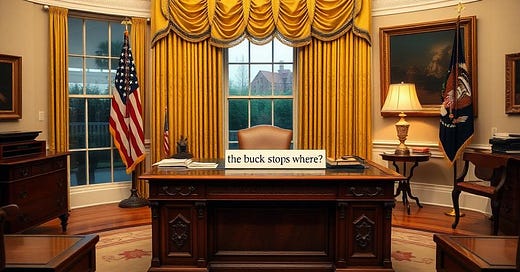The Unitary Executive, Self-Government, and a Limited State
Maybe we need more democracy and more distribution of power?
I have a piece now running over at Law & Liberty that might interest you. It’s on the “unitary executive” theory.
Wait! Before you hit delete, let me explain why this is an interesting subject even for the 99.999% of us who don’t practice constitutional law for a living. And why I’m sort of in favor of it. Mostly. Just not entirely.
I’ll be brief.
Today, when people debate the unitary executive, they are mostly fighting about the legitimacy of “independent” federal agencies. These entities often sit somewhere between the three branches (even though they are pretty clearly executive in nature). They also have some separation from the president.
The two main questions are 1) whether there are three and only three distinct branches of government, and 2) whether the executive branch has a single boss—the president.
I love this issue for a bunch of reasons. Some are historical—you can’t really get the unitary executive without understanding the Progressive Era, the New Deal, and the Great Society. Some are constitutional—you can see the Court wrestling (for more than a century now) with competing principles in cases like Myers v. US, Humphrey’s Executor, Morrison v. Olson, Seila Law, Collins v. Yellen, and more.
But what I find most interesting, at least at this moment, is how this theory intersects with our republican understanding of limited government. And how state constitutions are relevant to the discussion.
Before the modern fixation on individual rights, it was widely accepted that America’s republican form of government protected citizens from despotic governing via the separation of powers and democracy. Namely, if we divide power among a bunch of actors and make those actors answerable to the people, we can stop tyranny.
OK, here’s my punchline. I’m fascinated that many state constitutions divide the executive power among a whole host of elected officials. Depending on the state, it can include some combination of governor, attorney general, treasurer, state superintendent, agriculture commissioner, state board of education members, secretary of state, comptroller, insurance commissioner, and more.
In other words, states prevent tyranny by dividing and democratizing executive power to the hilt. So is a singular federal executive figure (the president) a good way to constrain Uncle Sam, or might it give one official too much power?
I don’t want to give you my conclusion here (read the piece!). I’ll just say this. I’m firmly opposed to undemocratic, independent, between-the-branches federal agencies. That’s contrary to American republicanism.
But in this era, when more democracy and more distribution of power might well be needed, I’m pretty sympathetic to the admittedly inefficient, fragmented executive model used in many states.
So what do I think about the unitary executive at the federal level?
Give it a read!






Well written and interesting! RE state constitutions: that feature of state constitutions, distributing executive power across multiple independently elected offices, wasn’t an accident. It was a cornerstone of a lowercase "d" democratic system designed to fragment power, prevent elite consolidation, and embed the public directly into governance as citizens in a democracy. This structure complemented locally grounded civic, legal, scientific, and economic systems to form the most economically effective and politically inclusive framework in world history. The Old Republic didn’t decentralize just to decentralize, it used that decentralization to produce real, distributed opportunity and local semi-autonomy to prevent economic and governmental central planning and unleash the creative talents of hundreds of millions.
Post ww2 centralizations across finance, law, education, science, and law/regulation gradually nullified these systems, replacing participatory diffusion with centralized technocratic control. But if global capital flows and institutional trust continue to falter, this decentralized model, fundamentally based within regional and local diversity and democratic access, could rise again as the only structure robust enough to rebuild legitimacy and shared prosperity